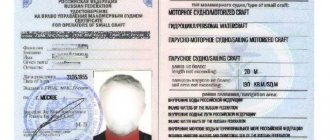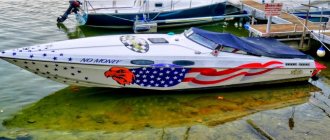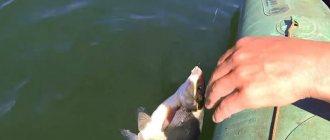Since 2021, new rules for registering small vessels (MS) have come into force, therefore the shape and size of the numbers have changed. Instead of 7 characters, there should now be 11. According to the new rules, an image of the Russian flag is also needed, if it is not installed on a flagpole or mast.
The registration number on the boat according to GOST GIMS must be covered in a contrasting color on both sides, and applied in such a way that the center of the number is located at a certain distance relative to the length of the hull of the vessel from the stem.
Taking into account the new rules for 2021, the height of numbers and letters remains at the same level - 15 centimeters, but due to the fact that the length of the number turns out to be 2 times larger than it was, then for most vessels (especially for PVC and jet skis) it does not physically fit, so the rules provide for permission to apply GIMS numbers of smaller sizes. It is physically possible to install the table on board, taking into account the characteristics of the boat. In these cases, the parameters and location of the new sample GIMS number must be determined by the registration authority. This is recorded in the ticket and MS database.
Different materials of numbers depending on the type of case
The choice of number will depend on the material of the boat hull:
- Rigid body and smooth side. If the body is hard, then a self-adhesive film number is best, which can be quickly applied (within five minutes) with little preliminary preparation. It does not require much drying time. This is not formal paint, but there should be no complaints from GIMS about this method of covering the number on the body.
- Rigid hull with irregular side. Often the body may look like this after improper painting or may already have obvious irregularities. In this case, it will not be possible to use a self-adhesive film, because it will not adhere completely or will not adhere well to a loose layer of paint. Then you can use a stencil and paint it - it will simplify the painting process and without it it will be difficult to follow all the dimensions strictly according to GOST.
- Swimming equipment made of PVC and RIB. PVC material has an unpleasant feature - all the paints eat away so much that it is impossible to remove them without spoiling the appearance, and the “self-adhesive film” does not adhere as firmly as it does on plastic and aluminum. But there are some peculiarities here - the main thing, when choosing an application method, is to take into account how often the boat will be rolled up.
Made from self-adhesive film
Easy to apply, does not damage the material, but is only enough for one season. Here you need to approach the choice correctly - if this is only the first boat, then you need to glue the number on, and not apply it with paint. It is possible that by the end of the season it will become clear that a different type of material is required - more or less, an inflatable bottom or solder, large or high-speed, for a powerful or weak motor, more complete or smaller, but more mobile.
The first boat is the first experience, so the thought of changing its color may come, but you need to understand that the side spoiled by the new paint can greatly worsen the likelihood of a sale, and if necessary, you will have to give in on the price. There shouldn’t be these problems with self-adhesive – no traces are visible, and after removal it looks like it came from a store.
From stencils for applying a number to a PVC boat
In another case, if you are already an experienced motorboater and understand that the motorboat will be in demand for a long period and then be passed on to your grandchildren, paint is applied without fear. It adheres well to PVC and adheres well.
An inexpensive method was proposed by the Shcherbakov brothers. It is necessary to use components such as the adhesive solution “Uran” and multi-colored nitro paint. In terms of quality, convenience and appearance, this is a cheap way.
First you need to test the paint and the application method - take part of the PVC material from the repair kit and conduct experiments on it. It is recommended to spend personal time on this matter, because there is a possibility of error; most paints work unpredictably - they begin to crack, imprint on the fabric during folding, and do not dry for a long time.
From the hanging room
They are called duplicate numbers - their use is justified if an awning is installed, but the main number is not visible. Awnings from trusted manufacturers have special pockets for this purpose.
Mounted number on a boat: the GIMS organization does not like it (it is prohibited to undergo a technical inspection with it), but on the water, inspection staff can be loyal to this type of identification, especially if it is “disguised”, the background is made to match the color of the boat (this option should always be ).
Most often, such numbers are fixed on board with the help of straps threaded through eyelets and held by rails, oarlocks, eyelets, etc.
The hanging number is made from PVC banner fabric and can be glued to the boat, in which case GIMS has no complaints (it becomes an integral part of the vessel).
PVC fabric
This is a special and expensive method of producing a number and applying it to the hull of a ship. The rigid board is a practical and affordable material on which self-adhesive film can be attached.
For an inflatable board for one season, self-adhesive tape or an invoice number may be suitable. And in order for the data on the boat to last for many years, it is better to use paint applied using stencils.
In what cases is it necessary to put a number on the vessel?
So, registration of license plates for boats, yachts, speedboats and other types of small water transport is regulated by the requirements of the state inspection. And these put forward requirements, in turn, are inextricably linked with the issues of registering boats and boats, as well as obtaining a navigation license.
In other words, if a small boat is registered with the State Inspectorate for Inspectorate, then the requirements for the number of the boat must definitely be observed. If, for good reasons, your boat is not registered with the State Inspectorate of Small Boats (GIMS), then the issue of registration of onboard identification marks does not concern you in any way. Actually, a boat receives a side number only as a result of state registration, so there simply cannot be any amateur activity here.
You may be interested: Outboard motor tax - tax rates by region, calculator
So the natural answer to the question posed in the title would be as follows:
All small vessels included in the GIMS register are required to have identification marks applied to the hull of the craft in the prescribed form.
Let’s find out what this “established form” is right now.
How to put a number on a boat according to GOST
Everything is clear with coloring substances and invoice numbers - in the first case, you need to read the instructions on the can, and in the second, fix it in place with ropes. But self-adhesive tape has its own characteristics.
The number on the PVC boat must comply with GIMS requirements. The owner of the boat must measure the length of the boat, find the middle of the reg. sign. To do this, you need to divide the length by 4 and measure the distance from the nose - this will be the middle. On the right and left sides you need to set aside boundaries of 875 millimeters. At such points there should be a number with a total length of no more than 1650 millimeters with the Russian flag.
Look at what the film is made of - don’t be fooled! It may be helpful to turn the number over to see the markings.
Not every film is the same! We recommend the Oracal 551 model - this is a moisture-resistant product with good protection from UV rays and mechanical damage - it is protected from liquids and the sun, does not mark or peel off, and does not fade for a long time. It is also called “automotive vinyl” and is designed for operation in conditions of air pollution. There is no need to wash it with gasoline and oils, but light dirt and harsh weather conditions will not harm it. You can quickly identify the real film from a fake product by the backing - it has a grid with a logo and suitable markings, as in the picture.
There are unscrupulous specialists who offer their analogues or the Oracal 640 series model. The first case has such a negative feature as the lack of a guarantee of results, and the second is the rapid loss of color by the film (fading), peeling off, which is associated with indoor use. The reason why experts offer such analogues is the relative cheapness of the product.
Surface preparation
Work should be carried out at a temperature of +10 C. If you need to do it outdoors, it is important to provide protection from strong winds. Otherwise, the number may “sail” a lot during installation, and dust and small particles will get under it, which is bad.
Now the most important thing is to prepare the surface. The most basic condition is that it must be crystal clear and as smooth as possible. Irregularities in the structure of the vessel do not matter (protruding elements, etc.), they are simply repeated by the film through plasticity. You should not leave uneven parts of the paint layer, chips on plastic, rivets, etc., where the material will not be pressed tightly.
"Dry" application method
This method is implemented in 10 steps:
- Peel off the film with the marks from the base.
- Clean the boat hull with any degreaser, not necessarily the best one. Alcohol is most often used.
- Prepare your number. From the very beginning it is aligned by signs and has 3 parts: backing, number, mounting film. Now you need to understand where the center of the number is (see above about the location of application), then move or cut the number, if necessary.
- Separate the mounting film and signs from the backing, gradually peeling off the transparent film so that only letters and numbers are on it.
- Place the film with the finished number against the hull of the watercraft. The material will not be very sticky. You need to press it along the borders in several positions, lightly (it is important not to forget about the wind if the work takes place outside, in an open and unprotected place. It is important not to press on the letters, they have a strong adhesive base). Align the number if necessary.
- Now that the owner is satisfied with the location of the number, you need to use a clean rag and begin to forcefully roll the number using the mounting film exactly according to the signs.
- Roll the number onto the side and remove the transparent film. After completing the initial rolling, carefully peel off the transparent mounting film. Each letter and symbol must be on board, and the “mounting” must be with you.
- Now you need to finally roll the symbols with a rag.
- The room is ready. It is recommended to wait 24 hours for the adhesive base to react. After this, the product will serve for a long time.
If large bubbles are noticeable after rolling, it is better to pierce them with a needle to increase reliability. But if they are small, then you need to leave it like that - slowly the film should “stretch” itself.
"Wet" application method
The “dry” method is suitable in 99% of cases, but sometimes you need to apply it “wet”. To do this, you need to prepare a slightly foamy solution (soap, fairy, etc.) and after the fifth point, slightly moisten the number and the side with foam. This will help you fine-tune the position, taking into account places where you can’t “get close” or on uneven and inconvenient places.
But then you will need to wait for it to dry completely and only then remove the film intended for installation. The method is time-consuming and is especially necessary when the board has a complex topography or films that are large in area are used (for example, a continuous pattern). This is necessary to avoid bubbles and to carefully glue the product.
Paste the flag
The flag should be after the number, and on the starboard side of the boat it will be closer to the bow, and on the left side near the center. It is important to take this point into account when applying the Russian flag.
Gluing process:
- Spray the soap solution onto the boat in the place where the flag will be applied so that the surface is well wetted.
- Take the flag of the Russian Federation and separate it from the backing (paper base).
- Press the flag onto the well-wetted side of the boat with the adhesive part. It will “ride” along the soap, which is what is required. This way you can correct it, it will not immediately join the board.
- Next, using a similar method, you need to apply all the remaining signs of the license plate to the side part (on a soap solution). Each symbol should be glued separately.
- When the entire number is completely applied to the pre-designated boundaries, the signs will “ride” on the soap solution and it will be possible to change the distance between the symbols, as well as the slope, centering, etc.
The distance between the flag and the last character in the number (the second digit of the country's region) should be 5 centimeters.
After aligning the symbols of the number, if you are satisfied with its location, take a plastic card and smooth out the printed symbols together with the flag so that the soap solution comes out and the signs stick to the side of the vessel. All the same steps must be performed on the other side of the boat and left to dry for 24 hours.
Board numbers from 2021
The identification number is applied in a contrasting color on both sides of the vessel. The center of the identification mark must be 1/4 of the hull length from the stem in one line. The height of letters and numbers must be at least 150 mm, width - 100 mm, and the thickness of font lines - 15 - 20 mm.
If, due to the design features of the vessel, it is not possible to carry the State Flag of the Russian Federation on a flagpole, mast or other ship's mast intended for this purpose, an image of the State Flag of the Russian Federation measuring at least 300 x 200 millimeters is applied to the hull of the vessel directly behind the assigned identification number or on another part of the ship’s hull in agreement with the relevant registration authority, which is recorded in the “Special Notes” sections of the ship’s ticket and the Register.
Conclusion
The given rules for applying the registration number must be taken into account to ensure a long service life of the product. The rules for applying a number according to GOST on a boat require that it be located in a suitable place on the hull of the craft, of a specified size, using a special indelible dye. It is possible to understand the meaning by which the Inspectorate operates: the number must be part of the boat, made in a standard form and easily readable, and its paint must be indelible. Signs are most often created from vinyl type film because it lasts for a long period of time.











